











|
Courtesy of the Jet Propulsion Laboratory
Circled by distinctive rings and attended by a group of at least 18 moons, Saturn has been called one of the most intriguing planetary realms in the solar system. Its largest moon, Titan, boasts organic chemistry that may hold clues to how life formed on the primitive Earth. So it is that Saturn and Titan will be the destination of the Cassini mission, a project under joint development by NASA, the European Space Agency and the Italian Space Agency. The U.S. portion of the mission is managed for NASA by the Jet Propulsion Laboratory. Cassini's principal objectives are:
Cassini was launched on October 15, 1997 atop a Titan IV-Centaur rocket from Cape Canaveral, Florida. Cassini will first execute two gravity-assist flybys of Venus, then one each of the Earth and Jupiter to send it on to arrive at Saturn in July 2004. Upon reaching Saturn, Cassini will swing close to the planet -- to an altitude only one-sixth the diameter of Saturn itself -- to begin the first of some five dozen orbits during the rest of its four-year mission. In late 2004, the spacecraft will release the European-built Huygens probe for its descent of up to two-and-a-half hours through the dense atmosphere of Saturn's moon Titan. The instrument-laden probe will beam its findings to the Cassini orbiter to be stored and finally relayed back to Earth. During the course of the Cassini orbiter's mission, it will perform some three dozen close flybys of particular bodies of interest -- including more than 30 encounters of Titan and at least four of selected icy satellites of greatest interest. In addition, the orbiter will make at least two dozen more distant flybys of the Saturian moons. Cassini's orbits will also allow it to study Saturn's polar regions in addition to the planet's equatorial zone.
| Views of Cassini & Huygens |
|---|
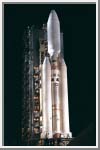 Cassini Orbiter and Huygens Probe aboard the Titan IV
Cassini Orbiter and Huygens Probe aboard the Titan IV
At Launch Complex 40 on Cape Canaveral Air Station,
the Mobile Service Tower has been retracted away from the Titan
IVB/Centaur carrying the Cassini spacecraft. The launch vehicle, Cassini
spacecraft and attached Centaur
stage encased in a payload fairing, altogether stand about 183 feet tall;
mounted at the base of the launch vehicle are two upgraded solid rocket
motors.
(Courtesy Kennedy Space Center)
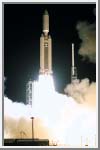 Launch of Cassini Orbiter
Launch of Cassini Orbiter
A seven-year journey to the ringed planet Saturn
begins with the liftoff of a Titan IVB/Centaur carrying the Cassini
orbiter and its attached Huygens probe. Launch occurred at 4:43 a.m. EDT,
October 15, 1997 from Launch Complex 40 on Cape Canaveral Air Station.
(Courtesy Kennedy Space Center)
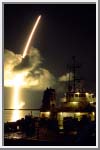 Cassini Orbiter and Huygens Probe aboard the Titan IV
Cassini Orbiter and Huygens Probe aboard the Titan IV
After a 2.2-billion mile journey that will include two swingbys of Venus and one
of Earth to gain additional velocity, the Cassini spacecraft will
arrive at Saturn in July 2004. The orbiter will circle the planet for
four years, its complement of 12 scientific instruments gathering data
about Saturn's atmosphere, rings and magnetosphere and conducting closeup
observations of the Saturnian moons. Huygens, with a separate suite of
six science instruments, will separate from Cassini to fly on a ballistic
trajectory toward Titan, the only celestial body besides Earth to have an
atmosphere rich in nitrogen. Scientists are eager to study further this
chemical similarity in hopes of learning more about the origins of our
own planet Earth. Huygens will provide the first direct sampling of
Titan's atmospheric chemistry and the first detailed photographs of its
surface.
(Courtesy Kennedy Space Center)
 Cassini (1997)
Cassini (1997)
This artist's rendering depicts the NASA/JPL Cassini spacecraft
in orbit around ringed Saturn (lower right background). At the
lower left, the European Space Agency's Huygens probe descends to
the surface of Saturn's moon Titan (in foreground).
(Courtesy NASA/JPL)
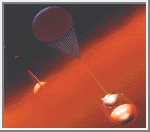 Huygens
Huygens
This artist's rendering shows the European Space Agency's Huygens
probe descending into the atmosphere of Saturn's
moon Titan after being released by NASA's
Cassini spacecraft.
(Courtesy ESA)
 Huygens
Huygens
This artist's rendering shows the European Space Agency's Huygens
probe descending into the atmosphere of Titan with Saturn in the
background.
(Courtesy ESA)
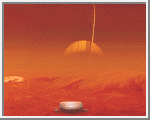 Huygens on Titan's Surface
Huygens on Titan's Surface
This artist's rendering shows the Huygens probe on the surface of
Titan.
(Courtesy ESA)
Views of the Solar System Copyright © 1997-2000 by Calvin J. Hamilton. All rights reserved. Privacy Statement.